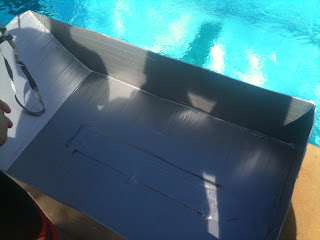I personally think that the cardboard canoe challenge this year wasn't as fun as the challenge last year and I really don't know the reason for that. It could be because there were no puzzles like last year (which I really enjoyed) or just because most of my best friends aren't in this class, that were in it last year. Anyways, I think that the Cardboard Canoe Challenge this year was still extremely fun, and I wish we could do it next semester aswell. This is definately a highlight for the year, for what is probably everyone in engineering class, just because it is so much fun to build and design something you can float in.
Achievements Earned: Eleven (11)
• Define the Problem and Brainstorm Solutions - State the problem you are designing a solution for. List at least 20 ideas you have regarding your solution. We are currently trying to design a boat that floats on water, made completely of cardboard/duct tape (Our Final design needed more cardboard, it sank)
• Criteria & Constraints - List or reference the specified Criteria and Constraints you're designing for. List at least one implied criteria. List at least three implied constraints.
The walls must be at least a foot tall
No cardboard can be showing (if touching the water)
You can use only cardboard and duct tape• Sketch Ideas - Draw 3 different sketches for possible designs. Label at least 3 key features for each sketch. Describe the feature's functionality so a viewer understands why the called out feature is important.
• Select an Approach - Generate feedback (+, change, ?, !) and make a decision matrix regarding your sketches/prototypes. Specify the approach you've chosen and justify your selection.
Build It! - Build your watercraft. Document it with a presentable photo.
(refer to photo section)
• The Early Bird Gets the Achievement - Awarded to the team with the fastest build.
We finished the boat before any other team. "Team Fire and Ice"
Reflection Achievements:• Feedback - Generate ten items of feedback for your effort (from the design/build process and/or the actual product). Make sure you include at least one item of feedback in each of our four feedback areas (+, change, ?, !)
Reflection Achievements:• Feedback - Generate ten items of feedback for your effort (from the design/build process and/or the actual product). Make sure you include at least one item of feedback in each of our four feedback areas (+, change, ?, !)
+ It was very fast, we had great teamwork (which is why we built is quickest), we had many ideas for our boat, about twenty. (4)
change We would add more layers of tape, I wish we could have gone with a different idea (more surface area) (2)? I am wondering why we didn't use an actual paddle, Why did you slant the front of the canoe? (2)
! I really liked the design of the shark on the front, It was a good idea to put the support on the middle of the canoe. (2)
• How Low Did You Go? - How low in the water did your canoe sit (roughly)? Was it surprising how little your boat went down in the water? Our canoe was extremely low in the water, and I was quite surprised at how low it was, simply because Michael is very light.
• Prototype Ideas - Craft physical prototypes (models) of each of your three sketches. Use a notecard or post it note to call out at least one key feature on each model. Post the images to your blog and describe the key feature that you've pointed out on each.
• Redesign - If we were to do another Cardboard Canoe race next semester, what would you build? Draw from everything you experienced in your class and propose the most competitive solution.
I think that is we did another Canoe race next semester, we would go with the exact same design (it was fast, just not efficient). I think what I would change on it would be the amount of cardboard used. We sort of used very little cardboard on the actual canoe.
• (Make Your Own Achievement) - Make an achievement of your own design that you can award yourself for something awesome your team did. "The Seahorse Chariot" Find a way to have your teammates pull your canoe, without actually touching the cardboard canoe itself. What we did was tie duct tape to the canoe, and tie the duct tape around Jesse and Kyler so they could swim, whilst simultaneously pulling the canoe.
Here are some fun photos of our boat design, the actual competition, and just pictures of people having fun.
You can refer to some of these photos for proof of our achievements.
























































